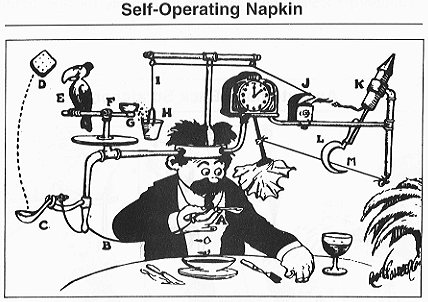‘Grotesquely complex’ is the point
- James Tyler
- Nov 21, 2022
- 2 min read
Imagine you have been eating and want to wipe your mouth with a napkin. Sounds like it should be a fairly easy thing to do. But what if it entailed using levers, pullies, a clock, a rocket – even a parrot?

If that’s the case, then you have entered the wacky world of Rube Goldberg machines. Reuben Garrett Lucius Goldberg illustrated his “Self-Operating Napkin” in one of the many wacky comic strips he created for the New York Evening Mail that were syndicated nationally. “The Inventions of Professor Lucifer Gorgonzola Butts” ran from 1914 to 1964.
Goldberg had studied engineering at the University of California, Berkeley, before later becoming a cartoonist. In 1914 he created his first Rube Goldberg machine style of comic, which was called the “Automatic Weight Reducing Machine.”
He was a Pulitzer Prize-winning illustrator and the creator of other popular strips, like Foolish Questions, Mike and Ike, and Boob McNutt, but it’s the strips that depicted those complicated contraptions doing simple tasks that made “Goldbergian” an adjective meaning “grotesquely complex: contrived with inept and excessive intricacy.”

His newspaper cartoons have spurred a wild and wonderful array of Goldberg machines in the real world, inspiring many physics and engineering teachers to push their students to create their own devices. It can be a fun way to learn basic scientific principles, such as conservation of energy, conservation of momentum or how force is used in any engineering project with pulleys, cranks or counterweights.
Purdue University in Indiana is world-renowned for its science and engineering education and its research advances. So why not host a Rube Goldberg machine challenge? The campus chapter of Theta Tau, a professional engineering fraternity, for years sponsored just such a contest for college students nationwide.
A different Rube Goldberg Machine Contest is geared for elementary, middle school and high school students. And companies around the world also get into the action. YouTube is rife with examples of varying complexity.
I admit to being easily sucked into watching videos that feature a Rube Goldberg machine in action whenever I encounter them. There’s something rather magical about these silly inventions. But it’s not magic – just physics, engineering, creativity and a lot of hard work to get it right.
If there is anything magical going on, it’s that a silly comic strip created more than a century ago featuring an inventor and his crazy contraptions would have launched an ongoing, world-wide enthusiasm for learning science, technology, engineering and mathematics principles in a such a fun, interactive way.
In a way, it feels like a big Rube Goldberg machine in action!
Image credits
Professor Butts and the Self-Operating Napkin. Originally published in Collier’s, Sept. 26, 1931.
Advertisement in “The Moving Picture World”



Commentaires